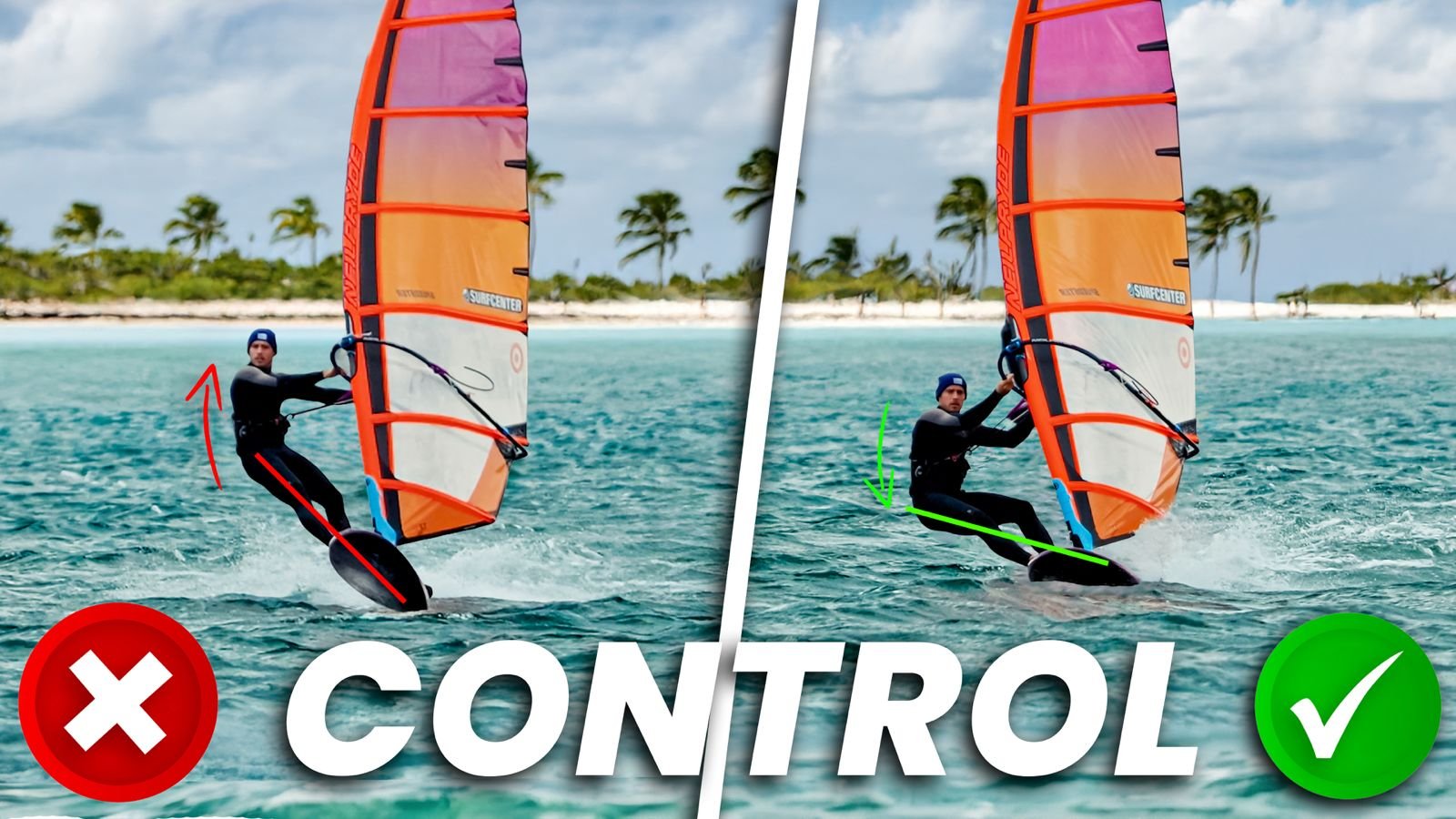🚨 AVOIDE THESE MISTAKES | High Wind Control for Windsurfing
We’ll cover:
Step 1: The Trim
Step 2: Technique
Step 3: Fitness
Step 4: Mindset
Step 1: The Trim
We’ll assume you’re already rigged on the beach and can’t or don’t want to change your gear. Maybe it’s super gusty and you need your big sail to stay planing during lulls.
Here are three quick gear adjustments you can make right on the beach:
1. Increase the Outhaul Tension
Flattening the sail profile reduces pull. But beware—too flat makes the sail unstable and overly reactive to wind drops. If it starts to feel twitchy and unstable, ease off a bit. The ideal outhaul tension varies by sail brand and model.
2. Lengthen Your Harness Lines
Use adjustable harness lines, ideally 2 to 4 inches longer than your regular setup. This lets you shift your body weight further outboard, giving you more leverage to control the sail and creating a buffer against being pulled over the board’s center. Just remember: your weight should stay in the harness, not your arms.
3. Lower the Boom
A lower boom helps transfer more pressure to the mast base, keeping the board planted. But don’t overdo it—too low and you’ll push too much water, making it harder to control. Aim for chest-height boom positioning, assuming everything else is correctly trimmed.
Step 2: Technique
Now that your gear is tuned, let’s focus on how you use your body on the water. Here are three things you can try right away when you’re overpowered.
1. Push the Hip Outboard
With longer harness lines, you can extend your hip outboard while keeping your upper body close to the rig. This gives you more leverage. Don’t confuse this with light-wind technique, where the upper body goes outboard. In strong winds, hip out, upper body in is the way to go. Tighten your abs like someone’s about to punch you in the stomach!
2. Leverage Your Weight Correctly
Now that you’ve got leverage, use it effectively. Sheeting in not only powers the sail but also helps keep the board glued to the water in gusts or chop. Key tip: pull your harness lines down, not just sideways. This complements your hip movement and helps you “sit into” the harness, creating stability.
Seat harnesses support this well, but they come with downsides. Ideally, a snug waist harness that doesn’t ride up is your best option.
3. Anticipation
Learn to read the water. Look upwind and in front of you to spot signs of gusts—wrinkles, darker patches, or foam caps. If you can react before a gust hits, you’ll maintain much better control.
Step 3: Fitness
This topic deserves its own video, which is on the way. For now, here’s what you should aim for:
Windsurfing demands full-body fitness. If you track your sessions with a fitness watch, you’ll know how often you hit high heart-rate zones.
Endurance Training
Build your base with long sessions of running, biking, or rowing at 60–70% of your max heart rate. Supplement with interval training that pushes you near max intensity.
Strength & Core Stability
Core stability helps keep you and your gear under control—and it prevents injuries, especially to your back. Even when you can’t be on the water, regular training pays off.
I even made a home workout routine back during COVID.
Step 4: Mindset
I promised this would be short—but it’s incredibly important.
Windsurfing is a sport where nature sets the rules. That teaches you a lot about yourself, and especially about your mindset.
Stay humble. Don’t jump straight into the gnarliest session of the year. Progress gradually and respect the wind.
Trust the process. Windsurfing takes a long time to master. Don’t beat yourself up if something doesn’t click in two sessions.
Have fun. If you enjoy what you’re doing, you’ll keep practicing and improving. That’s the real reward—having the best time of your life while progressing.
Final Thoughts
Time to put these tips into practice!
If you want to windsurf with me in person, check out my windsurfing experiences.
www.surfcenter-experience.com
Looking for new gear? Visit my shop online or reach out on WhatsApp. We’re here to help you find the setup that works best for you.
www.surf-center.com
Thanks for reading—and I hope to see you out on the water soon! 🌊
Checklist
✅ The Trim – Tune Your Setup
Already rigged? No worries. These quick adjustments make a big difference.
☐ Increase Outhaul Tension
→ Flattens sail to reduce power
→ Don’t overdo it—too flat = unstable sail
☐ Lengthen Harness Lines by 2–4 inches
→ Helps bring your body further outboard
→ Increases leverage and prevents being pulled over
→ Keep weight in the harness—not in your arms
☐ Lower Boom (Chest Height)
→ More pressure on mast base = board stays planted
→ Don’t go too low—can cause excess drag
✅ Technique – Use Your Body Smartly
☐ Push Hip Outboard
→ Hip out, upper body close to the boom
→ Engage your abs—think “someone’s punching your stomach”
☐ Leverage Weight by Pulling Harness Lines Downward
→ Keeps sail powered and board connected
→ “Sit into” the harness—especially helpful in gusts
→ Waist harness preferred for mobility & comfort
☐ Read the Water – Anticipate Gusts
→ Look upwind for foam caps or surface wrinkles
→ Adjust early, stay ahead of the gust









